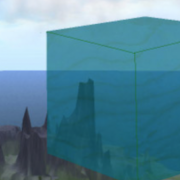Freshwater: The Real Meaning of Rain
Homer Simpson was joyous: ‘Water, water everywhere,’ he says to Bart on a fishing trip, ‘so let’s all have a drink!’ The Ancient Mariner was gloomy: ‘Water, water every where, nor any drop to drink.’ These two great fictional philosophers sum up a giant global problem: we all want to drink – but more than 97% of the water on our blue-water planet is salty. And desalination is unaffordable. Thus, water shortages – and more to come, if we don’t take better care of our freshwater reserves.
But less-than-3% is still 35 million cubic kilometres of freshwater – and even one cubic kilometer of water is a breathtaking amount. Imagine, outside your window, a giant, quivering box of water, a kilometre long, a kilometre wide, and a kilometre deep. That’s one cubic kilometre of water. It’s mind-boggling, terrifying: I’d hate that box to split and gush all over my house.
Now multiply the size of that box by a hundred, and try to imagine that gigantic water box outside your window, covering the land as far as you can see and then disappearing beyond the horizon. And then imagine a hundred of those gigantic boxes, spread across the country you live in – and you would still have only imagined 10,000 cubic kilometres of water.
You would have to imagine scattering a thousand of those 10,000 cubic kilometre boxfuls spread around the 200 or so countries in the world, and then you would have to repeat that exercise three and a half times, to get to 35 million cubic kilometres. Well, it’s more than my imagination can stretch to, visualizing that much water (and I definitely don’t want it falling on my house).
So isn’t that enough water for us to manage on? Unfortunately, says Fred Pearce in his riveting When the Rivers Run Dry, two-thirds of this freshwater is inaccessibly frozen, locked away as ice and glaciers. And even the greater part of the liquid one-third is hard to reach: it’s underground, in the pores of rocks – with the largest of these ‘aquifer’ reserves, ironically, under inhospitable deserts like the Sahara.
Worse, when we do burrow down to use aquifers, we quickly dry them out, unless they are re-filled naturally by rain: but rain only refills a minute 0.1% of aquifer water each year.
So how much water does that leave us, that is fresh, liquid and above ground? Only a smidgeon, says Pearce, just 200,000 cubic kilometers. And even that is not sitting around handily in a river or a pond waiting for us to come and dip our buckets in. Around 90,000 cubic kilometres are in permafrost and soils. A further 25,000 cubic kilometres disappear into atmospheric water vapour (13,000), or swamps and wetlands (11,000), or ‘living organisms, from rainforests to you and me’ (1,000). Sucking water out of people is not an option – and doesn’t melting permafrost release enough methane to fry us irrevocably?
Thank heavens, lakes hold some 90,000 cubic kilometres of freshwater. I’m seeing lakes with a new reverence now: I’d only regarded them as serene and beautiful before. But without them, where would we be? The world’s rivers contain only a measly couple of thousand cubic kilometres at any one time. The mighty Thames has just 2-3 cubic kilometres coursing through its banks in a whole year. (Phht! I can imagine that much outside my window, any day.) And of course the rivers then run towards the coast to hurl their treasure of freshwater with wild abandon into the salty sea…
Given all this, how much water do the world’s citizens actually have available? Pearce reckons that if the world’s freshwater were to be shared equally between us, we’d each have a mere 1,400 cubic metres (not kilometres, just metres) per year. I already use up more than that! Probably around 1,500-2,000 cubic metres, mostly through what I eat and drink [see Mythbuster 2 on how much water it takes to make a café latte]. I need to reduce my water footprint, pronto.
In the developing world, the ‘green revolution’ is a thirsty form of agriculture: the new crops that deliver ‘more crop per hectare’ often produce ‘less crop per drop’ than the varieties they replaced: ‘The world grows twice as much food … [but] abstracts three times as much water from rivers and underground aquifers to do it.’
Pearce’s vision is grave: Without a ‘blue revolution’, he sees rivers run dry, underground water reserves exhausted and fields caked in salt. Salt? The Ancient Mariner’s voice reverberates, as salt invades once-arable land through irrigation: ‘Each year, ten million hectares of fields are lost to its toxic embrace.’
What replenishes the water we use? Evaporation, making water rise from the sea, leaving the salt behind, to fall again ’re-freshed’ as rain. Precious rain. This book has re-opened my eyes to rain: it is not just an inconvenience to complain about if we get soaked, waiting at a bus-stop, or if a drizzle spoils a Sunday in the garden. It is time to remember the real meaning of rain.




Leave a Reply
Want to join the discussion?Feel free to contribute!